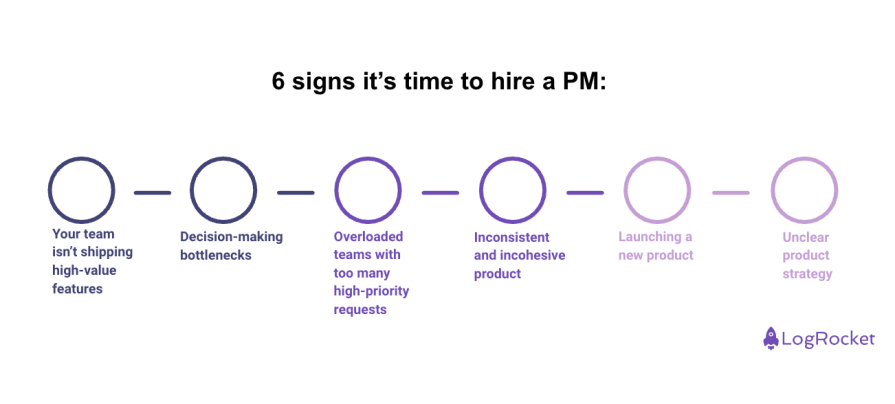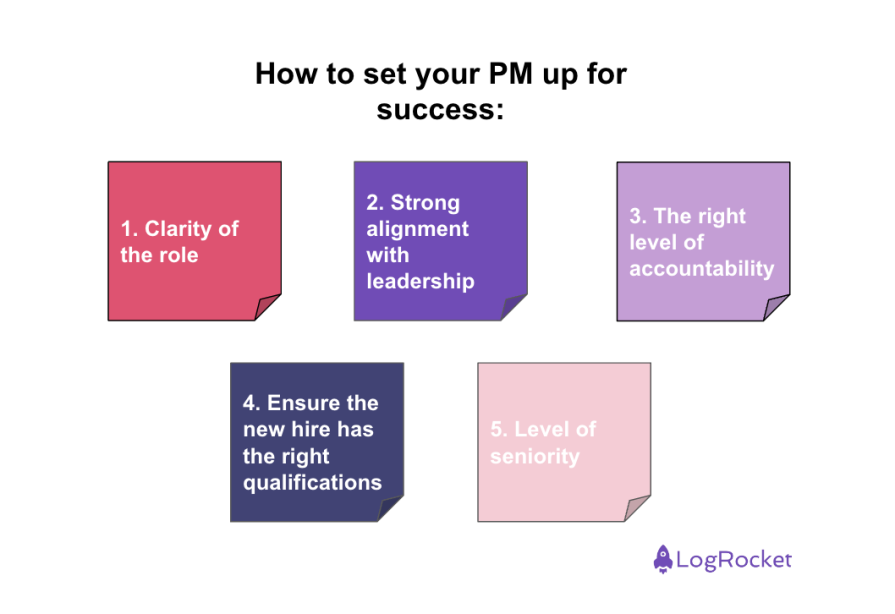When it comes to managing a product, hiring your first PM can be the game changer that you need to optimize your features and take on market share. However, it can be challenging to pitch the need for a PM because of the difficulty of immediately quantifying the value of the role. In organizations facing budget constraints, you might lean more towards hiring a new sales role to directly generate revenue or an engineer who can increase development capabilities.

That said, PMs play a pivotal role in the long-term success of a product. The real value of a PM emerges as you begin to shift your priorities towards extended and sustained growth.
Keep reading to learn all the information you need to make an informed decision about when to hire a product manager.
Why hiring your first product manager is a high-stakes decision
Hiring your first product manager can be a challenging decision because of the difficulty of neatly articulating their value. The impact of a PM is more nuanced than something like customer success. They operate across multiple functions, often without obvious or immediate metrics to show their contribution.
And yet, product management is critical for any software company looking to expand. A PM reduces the time it takes to deliver value to customers. They act as a vital link between customers, engineering, and the business to align product strategy with user and company goals.
When to hire your first PM? Insights from successful companies
In recent research, Lenny’s Newsletter analyzed 30 successful companies to understand the stage that each brought a product manager in.
On average, product companies brought on a PM with 10 to 15 engineers and 15 to 25 total employees. However, there was significant variation. For example, some hired a PM in the company’s first year, while others in the seventh year, when the company had roughly 100 employees and 30-50 engineers.
For the companies who hired later, the reasons for delaying varied. Stripe waited five years because it prioritized hiring highly skilled, product-minded engineers who could handle both engineering and product responsibilities. Others delayed because it took longer to achieve product-market fit.
On the other hand, companies that hired a PM early often did so because of a need to effectively manage the product function.
6 signs it’s time to hire a dedicated product manager
In early-stage startups, someone naturally takes on product management responsibilities, often without formally realizing it. Typically, this falls on the founder, CEO, or sometimes the CTO.
In the beginning, this setup works—especially before product-market fit is achieved, when the product is still evolving. However, as the company grows, the roles of the CEO or CTO expand. Juggling product management with these added responsibilities becomes increasingly difficult.
Here are the six key signs it’s time to hire a dedicated PM:

Your team isn’t shipping high-value features
This is a major indicator that prioritization needs improvement.
Review your team’s demos or release notes. Are the features you ship the ones that deliver the most value?
Evaluate the product. Do you notice any low-value features? Would omitting these features negatively impact the business? What does the data say?
If a team of five engineers is shipping 20 percent of features that aren’t providing sufficient ROI, a budget for hiring a PM can easily be justified.
Decision-making bottlenecks
Without a dedicated PM, decision-making can slow down.
If teams are constantly waiting for the founder’s input or if there’s no clear decision-maker, key decisions pile up. This leads to decreased productivity and missed opportunities. In some cases, poor decisions stem from a lack of full context, further affecting the product’s progress.
Talk to your team. Are they frustrated by the speed of decision-making? If so, it may be time to bring in a PM to streamline the decision-making process and keep things moving efficiently.
Overloaded teams with too many high-priority requests
It might seem like the solution is to expand your team, but before making new hires, ask yourself: Is there someone who can objectively assess the ROI of these requests? Is there a system in place to prioritize them and identify low-value tasks that don’t pose a risk to the business?
A dedicated PM can implement a clear prioritization framework, helping to balance competing demands and maximize ROI. With clearer priorities, the pressure on the team also decreases, improving overall efficiency.
Inconsistent and incohesive product
When product management is spread across different roles, misalignment becomes a major issue. Conflicting priorities, a lack of unified vision, and fragmented ownership create an incoherent product strategy that eventually shows in the final product.
Examine your product. How clear and usable is it? Are the features aligned and in the right place? Is everything cohesive and consistent? Are you constantly reworking features due to incomplete context or suboptimal decisions?
Reworking features wastes time, drains resources, and frustrates the team. If your company is experiencing these issues, it’s a sign that you need a PM.
Launching a new product
If your company is expanding its product portfolio, launching a new product will likely require a dedicated PM. Tasks like customer discovery, interviews, competitive analysis, and MVP prioritization are essential during this phase. It’s crucial to set the foundation right to minimize the potential for rework later on.
While founders often manage these responsibilities for the first product, adding new products to an established portfolio requires someone with PM expertise and dedicated time to guide the process and prevent costly rework.
Unclear product strategy
Talk to team members, especially those involved in decision-making about which features to build. Do they have a clear understanding of the product strategy? Can they assess the value of a new feature? Do they understand the product’s competitive advantage?
If you’re getting inconsistent or vague answers, it’s a sign that more time needs to be spent refining and communicating the product strategy.
How to set your new PM up for success
Hiring for a new role, especially a PM, can be tricky and requires careful consideration.
You likely don’t have the experience to compare good versus bad candidates, there’s no clear blueprint for key responsibilities and goals, and there’s no predefined career path for the new hire.
That said, ensure the following factors are in place to give your new PM the best chance to succeed:

Clarity of the role
Take the time to clearly define the role. The responsibilities of a product manager can vary greatly depending on the company’s stage, industry, and needs. It may involve strategy, execution, market research, user experience, and more.
Strong alignment with leadership
Ensure the new PM understands the vision of the company founders.
This is an opportunity for the PM to help foster a product-centric culture. Is this vision aligned with leadership? If the first PM isn’t on the same page as leadership, it can lead to miscommunication or conflict over product direction.
The right level of accountability
Hiring a PM shouldn’t come from the desire for the founder to focus on vision and strategy while the PM handles all the grunt work. This is a poor deal for the new hire.
On the other hand, completely handing over the product without maintaining involvement is also problematic, as it can signal that leadership doesn’t view the product as important or strategic.
Ensure the new hire has the right qualifications
A PM role requires many qualifications, such as strong communication, technical knowledge, strategic thinking, and leadership skills.
However, the first PM needs more than that. They must be comfortable building from the ground up. This means handling both the high-level product vision and the granular day-to-day execution.
Finding someone who can balance both is often a challenge.
Level of seniority
The level of seniority depends on the company’s stage. In very early-stage startups, where the founder has product skills and remains closely involved, it might be fine to hire a more junior PM who can grow over time.
However, at the stage where the founder is ready to hand off product management and soon build a product team, hire someone with at least five to six years of experience in a similar role. Hiring someone too junior may result in a lack of skills to drive the product strategy effectively. On the other hand, hiring someone very senior may be challenging, as they might struggle with the hands-on work needed during the early phases.
Final thoughts
There’s no one-size-fits-all answer for when to hire a PM. Every company has unique needs, and the right timing depends on your stage of growth and the specific challenges you face.
Reflect on the current obstacles you’re encountering due to the absence of this role. Can hiring a PM address these issues? Will the addition create enough value for the business, both in the short term and long term?
Getting the timing right is important. When your company is ready to scale, a PM can help you elevate both your product and business to the next level.
Featured image source: IconScout